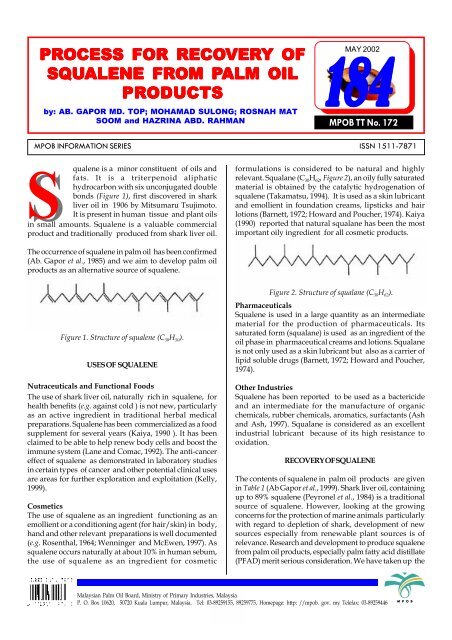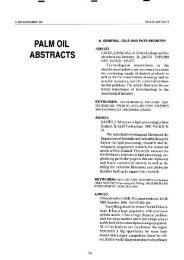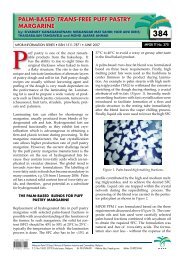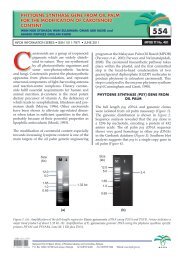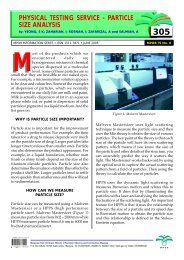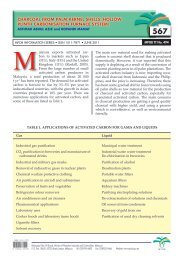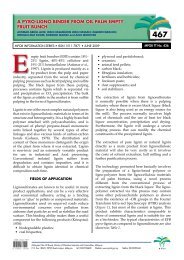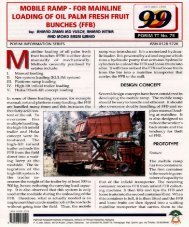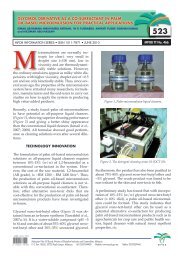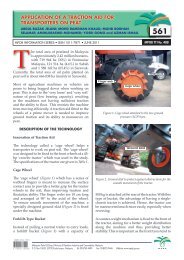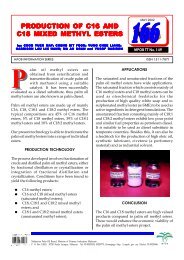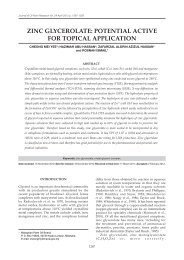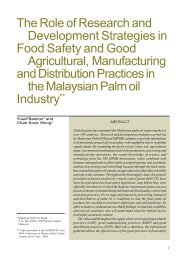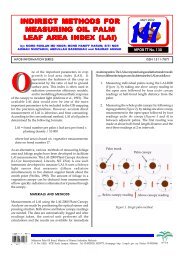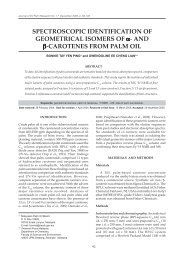Process for recovery of squalene from palm oil products
Process for recovery of squalene from palm oil products
Process for recovery of squalene from palm oil products
Create successful ePaper yourself
Turn your PDF publications into a flip-book with our unique Google optimized e-Paper software.
MAY 2002<br />
PR PROCESS PR OCESS FOR FOR RECO RECOVER<br />
RECO VER VERY VER Y OF<br />
OF<br />
SQ SQUALENE SQ ALENE FR FROM FR OM P PPALM<br />
P ALM OIL<br />
OIL<br />
184 184 184 184 184<br />
PR PRODUCTS<br />
PR ODUCTS by: AB. GAPOR MD. TOP; MOHAMAD SULONG; ROSNAH MAT<br />
SOOM and HAZRINA ABD. RAHMAN MPOB TT No. 172<br />
MPOB INFORMATION SERIES ISSN 1511-7871<br />
S<br />
qualene is a minor constituent <strong>of</strong> <strong>oil</strong>s and<br />
fats. It is a triterpenoid aliphatic<br />
hydrocarbon with six unconjugated double<br />
bonds (Figure 1), first discovered in shark<br />
liver <strong>oil</strong> in 1906 by Mitsumaru Tsujimoto.<br />
It is present in human tissue and plant <strong>oil</strong>s<br />
in small amounts. Squalene is a valuable commercial<br />
product and traditionally produced <strong>from</strong> shark liver <strong>oil</strong>.<br />
The occurrence <strong>of</strong> <strong>squalene</strong> in <strong>palm</strong> <strong>oil</strong> has been confirmed<br />
(Ab. Gapor et al., 1985) and we aim to develop <strong>palm</strong> <strong>oil</strong><br />
<strong>products</strong> as an alternative source <strong>of</strong> <strong>squalene</strong>.<br />
Figure 1. Structure <strong>of</strong> <strong>squalene</strong> (C 30H 50).<br />
USES OF SQUALENE<br />
Nutraceuticals and Functional Foods<br />
The use <strong>of</strong> shark liver <strong>oil</strong>, naturally rich in <strong>squalene</strong>, <strong>for</strong><br />
health benefits (e.g. against cold ) is not new, particularly<br />
as an active ingredient in traditional herbal medical<br />
preparations. Squalene has been commercialized as a food<br />
supplement <strong>for</strong> several years (Kaiya, 1990 ). It has been<br />
claimed to be able to help renew body cells and boost the<br />
immune system (Lane and Comac, 1992). The anti-cancer<br />
effect <strong>of</strong> <strong>squalene</strong> as demonstrated in laboratory studies<br />
in certain types <strong>of</strong> cancer and other potential clinical uses<br />
are areas <strong>for</strong> further exploration and exploitation (Kelly,<br />
1999).<br />
Cosmetics<br />
The use <strong>of</strong> <strong>squalene</strong> as an ingredient functioning as an<br />
emollient or a conditioning agent (<strong>for</strong> hair/skin) in body,<br />
hand and other relevant preparations is well documented<br />
(e.g. Rosenthal, 1964; Wenninger and McEwen, 1997). As<br />
<strong>squalene</strong> occurs naturally at about 10% in human sebum,<br />
the use <strong>of</strong> <strong>squalene</strong> as an ingredient <strong>for</strong> cosmetic<br />
<strong>for</strong>mulations is considered to be natural and highly<br />
relevant. Squalane (C 30H 62, Figure 2), an <strong>oil</strong>y fully saturated<br />
material is obtained by the catalytic hydrogenation <strong>of</strong><br />
<strong>squalene</strong> (Takamatsu, 1994). It is used as a skin lubricant<br />
and emollient in foundation creams, lipsticks and hair<br />
lotions (Barnett, 1972; Howard and Poucher, 1974). Kaiya<br />
(1990) reported that natural squalane has been the most<br />
important <strong>oil</strong>y ingredient <strong>for</strong> all cosmetic <strong>products</strong>.<br />
Figure 2. Structure <strong>of</strong> squalane (C 30H 62).<br />
Pharmaceuticals<br />
Squalene is used in a large quantity as an intermediate<br />
material <strong>for</strong> the production <strong>of</strong> pharmaceuticals. Its<br />
saturated <strong>for</strong>m (squalane) is used as an ingredient <strong>of</strong> the<br />
<strong>oil</strong> phase in pharmaceutical creams and lotions. Squalane<br />
is not only used as a skin lubricant but also as a carrier <strong>of</strong><br />
lipid soluble drugs (Barnett, 1972; Howard and Poucher,<br />
1974).<br />
Other Industries<br />
Squalene has been reported to be used as a bactericide<br />
and an intermediate <strong>for</strong> the manufacture <strong>of</strong> organic<br />
chemicals, rubber chemicals, aromatics, surfactants (Ash<br />
and Ash, 1997). Squalane is considered as an excellent<br />
industrial lubricant because <strong>of</strong> its high resistance to<br />
oxidation.<br />
RECOVERY OF SQUALENE<br />
The contents <strong>of</strong> <strong>squalene</strong> in <strong>palm</strong> <strong>oil</strong> <strong>products</strong> are given<br />
in Table 1 (Ab Gapor et al., 1999). Shark liver <strong>oil</strong>, containing<br />
up to 89% <strong>squalene</strong> (Peyronel et al., 1984) is a traditional<br />
source <strong>of</strong> <strong>squalene</strong>. However, looking at the growing<br />
concerns <strong>for</strong> the protection <strong>of</strong> marine animals particularly<br />
with regard to depletion <strong>of</strong> shark, development <strong>of</strong> new<br />
sources especially <strong>from</strong> renewable plant sources is <strong>of</strong><br />
relevance. Research and development to produce <strong>squalene</strong><br />
<strong>from</strong> <strong>palm</strong> <strong>oil</strong> <strong>products</strong>, especially <strong>palm</strong> fatty acid distillate<br />
(PFAD) merit serious consideration. We have taken up the<br />
Malaysian Palm Oil Board, Ministry <strong>of</strong> Primary Industries, Malaysia<br />
P. O. Box 10620, 50720 Kuala Lumpur, Malaysia. Tel: 03-89259155, 89259775, Homepage: http: //mpob. gov. my Telefax: 03-89259446
challenge and succeeded in producing pure colourless<br />
<strong>squalene</strong> (Figure 3). It is estimated that potential<br />
availability <strong>of</strong> <strong>squalene</strong> <strong>from</strong> PFAD is 1470 and 2205 t in<br />
year 2000 and year 2010 respectively (Ab. Gapor and<br />
Hazrina, 2000).<br />
TABLE 1. SQUALENE CONTENT IN PALM OIL<br />
PRODUCTS<br />
Oils and Fats Squalene (ppm)<br />
Mean Range n<br />
Crude Palm Oil ( a ) 580 537-659 3<br />
Crude Palm Oil ( b ) 588 421-979 11<br />
Bleached Palm Oil ( a ) 572 530-645 3<br />
RBD Palm Oil ( a ) 683 478-791 3<br />
RBD Palm Oil ( b ) 257 184-361 9<br />
Palm Fatty Acid Distillate( a ) 5 465 2 128-8 191 14<br />
Palm Fatty Acid Distillate ( b ) 7 887 2 404-13 504 16<br />
Notes: ( a ) Ab. Gapor et al. (1999).<br />
( b ) Ab. Gapor et al. (1985).<br />
Figure 3. Squalene (coloured and colourless).<br />
CONCLUSION<br />
Squalene finds applications in nutraceuticals, cosmetics,<br />
and pharmaceuticals industries. In view <strong>of</strong> the value <strong>of</strong><br />
<strong>squalene</strong>, we have researched and developed relevant<br />
process to recover it <strong>from</strong> <strong>palm</strong> <strong>oil</strong> <strong>products</strong>, to be<br />
capitalized accordingly.<br />
ACKNOWLEDGEMENTS<br />
We would like to thank the Director-General and Director<br />
<strong>of</strong> Engineering and <strong>Process</strong>ing Division <strong>of</strong> MPOB <strong>for</strong> their<br />
encouragement. Meriam Hassan, Mahani Rifaeh and<br />
Rahana Mohd. Kamal provided excellent technical<br />
assistance.<br />
REFERENCES<br />
AB. GAPOR ; KAWADA, T; WATANABE, H and MURUI,<br />
T (1985). Studies on minor compounds in <strong>palm</strong> fatty acid<br />
distillate. I. Occurrence <strong>of</strong> <strong>squalene</strong>. J. Jpn. Oil Chem. Soc.,<br />
34(7) : 551-553.<br />
AB. GAPOR MD TOP; MOHAMAD SULONG; MERIAM<br />
HASSAN; ROKIAH ABU and MAHANI RIFAEH (1999).<br />
Palm <strong>squalene</strong>: a valuable component <strong>of</strong> <strong>palm</strong> <strong>oil</strong>. Proc. <strong>of</strong><br />
1999 PORIM Int. P. O. Cong., 1-6 February. Kuala Lumpur,<br />
p.159-163.<br />
AB. GAPOR MD. TOP and HAZRINA ABD RAHMAN<br />
(2000). Squalene in <strong>oil</strong>s and fats. Palm Oil Developments,<br />
32 : 36-40.<br />
ASH, M and ASH, I (1997). Handbook <strong>of</strong> Industrial<br />
Surfactants. 2nd Edition,Vol. 2, published by Gower (USA),<br />
p.1935.<br />
BARNETT, G (1972). Emollient Creams and Lotions in<br />
Cosmetics, Science and Technology. Second Edition, Vol. 1,<br />
edited by Balsam M.S. and Sagaran E, Wiley- Interscience,<br />
p.27-104.<br />
HOWARD, G M and POUCHER, W A (1974). Perfumes,<br />
Cosmetics and Soaps. The Raw Materials <strong>of</strong> Perfumery.<br />
Chapman and Hall Ltd., p. 344.<br />
KAIYA, A (1990). The use <strong>of</strong> natural <strong>squalene</strong> and<br />
squalane, and the latest situation <strong>of</strong> the raw materials. J.<br />
Jpn. Oil Chem. Soc., 39(8) 5 : 25-529.<br />
KELLY, G S (1999). Squalene and its potential clinical uses.<br />
Altern Med Rev, 4(1) : 29-36.<br />
LANE, I W and COMAC, L (1992). Sharks Don’t Get Cancer:<br />
How Shark Cartilage Could Save Your Life. Avery Publishing<br />
Group Inc., New York.<br />
PEYRONEL, D; ARTAUD, J; IATRIDES, M C and<br />
CHEVALIER, J L (1984). Fatty acid and <strong>squalene</strong><br />
compositions <strong>of</strong> mediterranean Centrophorus SPP egg and<br />
liver <strong>oil</strong>s in relation to age. Lipids, 19 (9) : 643-648.<br />
ROSENTHAL, M L (1964). Biological role and practical<br />
uses <strong>of</strong> <strong>squalene</strong> and squalane. Cosmetics and the Skin,<br />
Edited by Lubowe I and Wells F.V., Reinhold Publishing<br />
Corp.<br />
TAKAMATSU, T (1994). Hydrocarbons. Cosmetic Raw<br />
Material Analysis and Quality, Edited by Butler H, Micelle<br />
Press, p.24-31.<br />
WENNINGER, J A and MCEWEN, G N (1997). Intern.<br />
Cosmetic Ingredient Dictionary and Handbook, published by<br />
The Cosmetic, T<strong>oil</strong>etry and Fragrance Association,<br />
USA,Vol. 2, p.1337-1338.<br />
For more in<strong>for</strong>mation kindly contact:<br />
Director-General<br />
MPOB<br />
P. O. Box 10620<br />
50720 Kuala Lumpur, Malaysia.<br />
Tel: 03-89259155, 89259775,<br />
Homepage: http: //mpob. gov. my<br />
Telefax: 03-89259446


